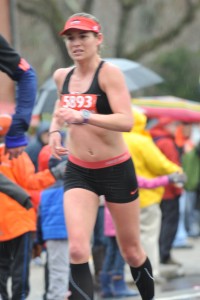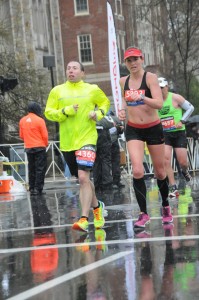If you’ve known me for long, you know that I’ve been on a quest to break 3 hours in the marathon since 2016. Between a few solid swings (3:03 finishes, multiple times), and then injuries, pandemic, etc – it felt like it would potentially never happen. However, sometimes patience and consistency truly do pay off, and I found myself ready to take my first swing at the marathon since 2019.
My original spring 2022 marathon goal was the Rotterdam Marathon, in The Netherlands. Known for a flat and fast course, with cool/damp weather, it felt like the perfect opportunity to take my chances. Training over winter went really well. I was running 60-65 mile weeks, with one double-run day, and my standard 3-5 days of strength training. No injuries, my speed was coming back – I was excited!

A few weeks before race day (3 weeks, I believe?), I began to panic: COVID numbers were creeping up again, and The Netherlands had just removed any/all COVID precautions. I began stressing about my first overseas trip since 2020 – would I finally get COVID? Would I get sick and get stuck in the Netherlands? To say I was stressing would be an understatement. The furthest thing from my mind was that 2:59, it was all the pandemic stuff out of my control.
I emailed my coach with my concerns, and suggested we find a state-side race instead that more or less fit the timeline. I was just about to knock out my last big week and then taper, so if I was potentially going to change the weekend, we needed to know asap.
After combing my favorite marathon databases, considering weather, course type, field size, accessibility, etc., I suggested the Revel Mount Charleston Marathon. To say that this race was an apple and Rotterdam was an orange wouldn’t do the comparison justice. Mount Charleston begins 7600 ft up, with a 5000 ft drop, with runners finishing outside of Las Vegas. I was considering a change in climate, altitude, and completely different demands on my body. However, I felt oddly confident that my legs could weather the endless eccentric contractions they’d endure on such an unforgiving course.
I don’t think my coach, Jason, was *quite as confident in this sort of course. They are incredibly risky, as legs can cramp or simply have nothing left long before the finish line. I was willing to give it a shot. I’ve raced well on hills – especially downhills. I train on rolling hills, and all of that strength training had to play to my favor.
So it was decided: Rotterdam would be replaced with Mount Charleston. I canceled travel, booked travel, and then we removed the last big week of training and I went right into the taper, because Mount Charleston was a week before Rotterdam.
Marathon weekend began the most frustrating way possible: flight delays that got us into Las Vegas after midnight. By the time we got to the hotel (we stayed on the Strip), and had dinner, it was 3am Friday. After what wasn’t exactly the best quality or quantity of sleep, my husband, Chris, dragged me out of bed and to my shakeout run Friday morning. While the last thing I wanted to do was leave the bed, I’m so glad he forced me to get up. The shakeout run felt heavy, slow and weird – but I felt much better after it.
After the shakeout, we picked up our rental car and drove to the race expo. The expo was easy to navigate, not at all crowded, and a smooth experience. Race day would include both the marathon and half marathon, but the vibe was very “small town race,” in the best way possible.
The rest of the day was spent relaxing, eating carbs, and shopping for throw-away clothes for the race start. Race weather was shaping up to be awesome: low 40s at the start, and then warming up to a sunny 65 degrees at the finish. Throw-way clothes are necessary for staying comfortable pre-race. With having to be at the shuttle bus at 3:30am, we were in bed early – though I don’t think I slept much at all.
My alarm went off around 2am. I told myself that jet lag was on my side. I ate a muffin and a donut with my coffee, and suited up in my race kit. With my throw-away layers on, we walked through the casino to the car. It’s very strange to be walking through the late Friday night Vegas scene, while you’re on your way to a marathon.
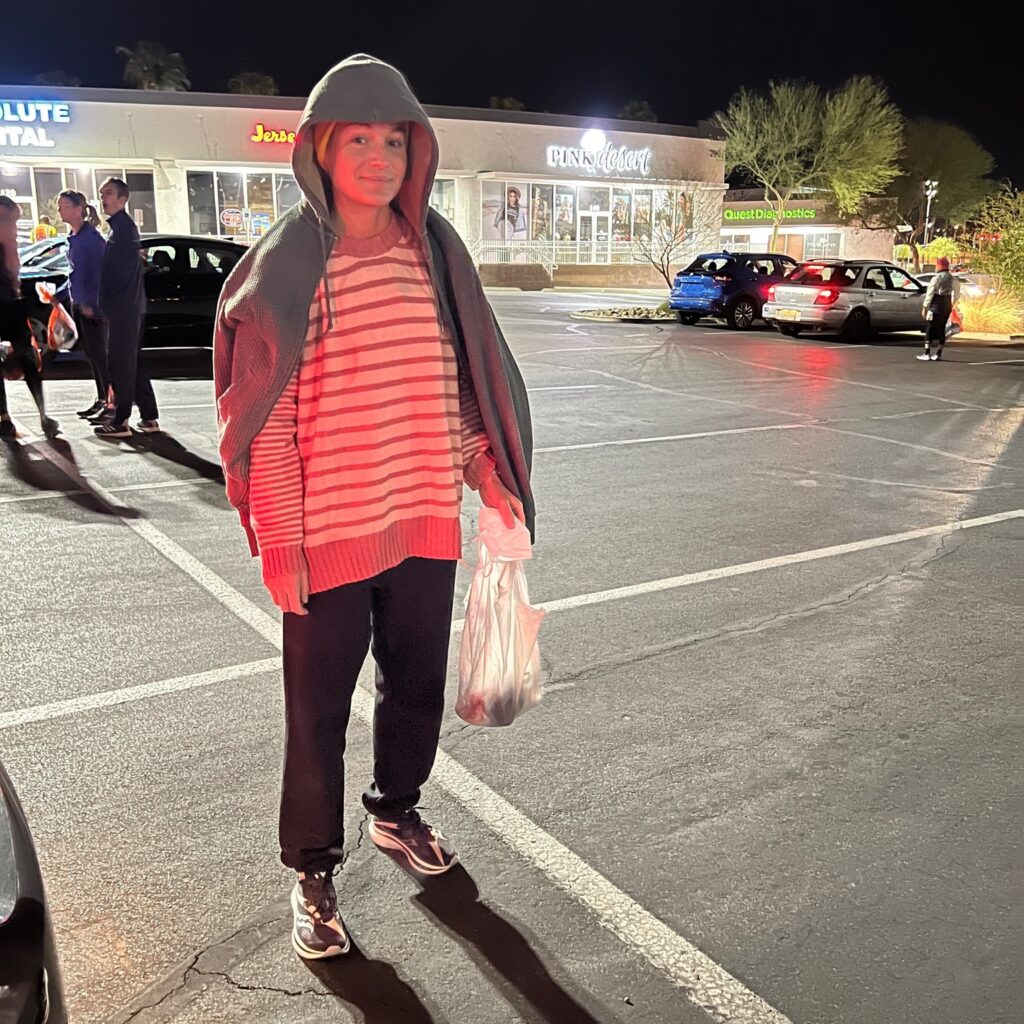
Getting to and onto the bus was very easy. The organization of the entire weekend was fantastic. I said goodbye to Chris, and snagged a window seat so that I could close my eyes and relax. Because the Mount Charleston course is a point-to-point race, and course runs through preserved land with few roads, spectators really aren’t allowed access the race course until the 20 mile mark. I knew Chris was going to be waiting for me at the finish. With my eyes closed, I relaxed my mind despite the buzz of nervous runners chatting. I could feel the bus climbing up and up, and as we neared the start area, snow lined the road.
Athlete’s Village was fantastic. There were fire pits for warmth, plentiful porta-potties, and tables with water and electrolytes. Despite getting there early (I’m always early to Athlete’s Village!), the time went by pretty quickly. I decided not to waste energy looking for the other two runners I knew who would be there. Nerves were low: I knew my strategy in pacing and fueling, and felt ready to execute my plan.
A few tips on this race: start slowly. You’re high up, so it’s possible that breathing will feel less than awesome. The course has a few ups in the first mile, so go by effort, allow your legs and lungs to warm up, and be patient. I packed salt pills as a last-minute decision, because Jason and I know I don’t do well in the heat. It was a guarantee that it would warm up, it was a matter of how quickly, and how well I could manage it. I took a pill within the first few miles of the race.
The race organization offers some incredibly detailed videos and breakdowns of the elevation of the race, so having done my homework, I knew mile 6-20 was going to be fast – and to be patient early and to dig deep late. I will caution that if a runner isn’t prepared for downhill running, or gets greedy and hammers this course, they may end up in a world of pain and having a disappointing performance and experience. With it being the desert, sweat evaporates quickly, making it deceptive with just how much one is sweating. Having raced a few times in the desert before, I knew I couldn’t go off of feel.
The race start happened right around sunrise, allowing us to finally see the beauty and drama of Mount Charleston. It was an incredibly picturesque place, and I recall wanting to soak it all in. Whatever nerves I had, and I hadn’t had many, turned to focus and fun within the first mile. It was cool and crisp, and I was happy to have my gloves, arm sleeves and head band on. I knew I’d peel them off as things warmed up, and was confident that my racing briefs and sports bra was the right choice.
With the exception of a few people who live on Mount Charleston, and the lovely volunteers at the hydration stations, there’s essentially no crowd support – just beautiful open space and the sound of breathing and shoes hitting the pavement. I found it peaceful, and dialed in my effort. While this quiet and remote marathon experience may not be for everyone, it didn’t bother me in the least. Perhaps having done much of my training solo over the years, and having done other more rural races, the quiet wasn’t jarring.
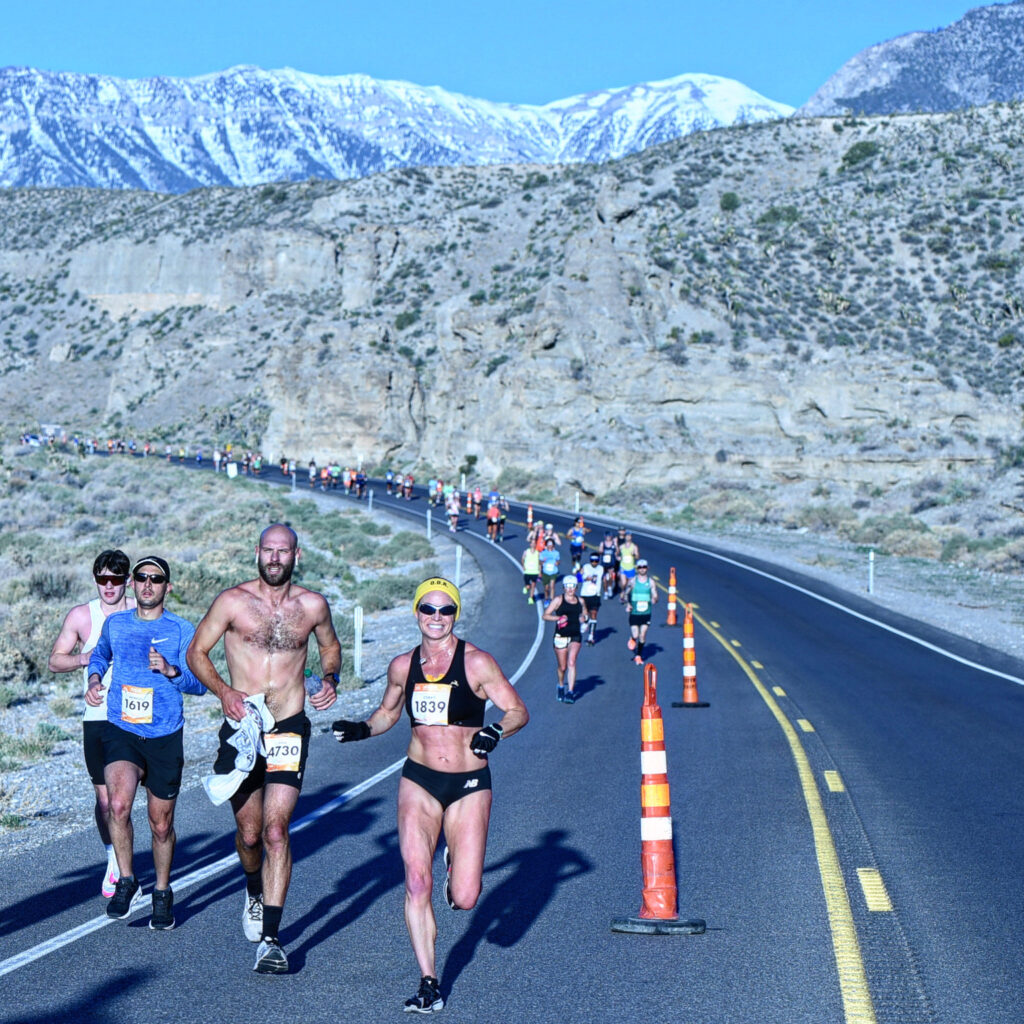
The first 6 miles or so include some serious downs, and a few ups. This is where I took a salt pill, and really began to understand how my legs would fair on the course, and what that meant in terms of pacing. For the first 6 miles, my splits were the following: 7:07, 6:30, 6:31, 6:33, 6:47, 6:35. I recall it feeling surreal: the combo of beauty, the hills, and how I felt – mentally I was in the zone, not thinking any more than I needed to, and allowing the miles to click by.
After mile 6, this race gets FAST. I forget the exact breakdown per mile regarding elevation, but the first 13 miles loses 3000 ft, and the second half loses 2000 ft. If the quads don’t die, and form for downhill running is strong, this can be a really fun race!
The following 6 miles felt effortless: 6:22, 6:24, 6:27, 6:34, 6:34, 6:35, 6:39. I reminded myself to never hammer, because risking my quads to bank time is a fool’s errand. Temperature began creeping up, and I was out of the shade of the canyon, exposed to the blue sky and abundant morning sunshine. In this stretch I ditched my arm sleeves and head band, though I held onto the gloves for a bit longer.
Around the half marathon mark, my stomach began acting a *little funky. Maybe it was the salt pill, or that I was getting my period that morning, but I became aware that I might need to make a bathroom stop. However, the stomach issue would come and go, and I decided at the mile 18 water station to be smart and use the port-potty. The splits from miles 14-18: 6:28, 6:33, 6:34, 6:36, 7:39 (porta-potty stop – which cost me about 60 seconds).
In my experience, if you need a bathroom and you take the detour, you’ll feel like a new person for the rest of the race. If I’d continued, stomach discomfort may have messed with my mind and my overall comfort. Well worth losing a minute to feel much better!
As the course nears miles 20, there is crowd support for the first time. This is a welcomed sight, as it was getting warm, and the elevation drop was less noticeable, meaning I had to readjust form and power after so much downhill to find my legs. It was around mile 20-21 that my right big toe became problematic. It felt like one moment I was fine, and the next I was being hit on the top of my big toe with a hammer with every step. I knew I wasn’t injured, but my guess was a blister had formed under the toenail. Between the force into the toe of the shoe, and this being my first race ever in super shoes (Suacony Endorphin Pros), and them being possibly a little on the small side for me, I had a good idea of what was happening.
I tried to be at peace with the pain – it was just a blister! But my form began changing and I briefly debating taking my shoe off and running barefoot for the final miles. Glancing at my watch, I was on pace for about a 2:53 finish – which was insane. I knew that I had to risk that time, and stopped on the course. I took off my shoe and sock, and took one of the pins from my race bib, in a harried attempt to puncture the blister under the nail and relieve the pressure.
A few kind half marathoners saw me, and offered me bandaids, but I politely said that the bandaids weren’t going to be helpful. After digging at my toe with the needle in an attempt to relieve pressure, I put the sock and shoe back on, and focused on moving forward. Splits from miles 19-24: 6:35, 6:41, 6:35, 8:17 (the rogue surgery mile), 7:15, 7:30.
After that little surgical delay, I struggled to get back to my rhythm. The toe was still painful, I could feel dehydration creeping in, and the course leveled out a bit. Plus, the final few miles of the marathon is simply tough! The last few miles took us runners through suburban neighborhoods. Having families out was nice, but boy did I miss the cool weather from the top of Mount Charleston!
In those last few miles, I knew that unless something catastrophic happened, I’d achieve what I’d been chasing for years: a sub-3 hour marathon. Even with paces slowing, I knew it was there. The final 2 miles: 7:17, 6:59, and the last .2: 6:33 pace. There was a little uphill climb in the last mile, which honestly felt like Mount Everest to my legs. The only real turn on the entire course is right at the finish. It felt brutal to decelerate only to try to kick it in!
Official finish time: 2:58:15, and 6th place female.
Honestly, I was in disbelief. It’s really weird to chase something for so long, and then to have it be in the past. If I’m honest, I was actually momentarily disappointed with my finish, because without the bathroom and foot issues, it could have been an even faster day. It’s funny how often our minds go to that sort of place, instead of honoring an achievement.

The finish area was well organized and stocked with snacks. There’s nothing quite like chocolate milk after a marathon. It was 65 degrees and sunny at the finish, so getting in calories and liquid was a priority. It felt surreal to be around runners and crowds after the pandemic. My first marathon since 2019, close to 3 years from the date, and it felt foreign and amazing at the same time. In hindsight, I think the smaller race field at Mount Charleston set me up for success. Rotterdam would have been a very large, big city feel, and could have very easily overwhelmed me after so many years of social distancing.
You better believe I took my shoes off as soon as I could! After finding Chris, I walked barefoot for about a mile to the car. Despite the 5000 ft of damage done to my legs, aside from my quads giving me the indicator that they’d be angry in the coming hours, I felt really good.
Upon arriving back at our hotel, I was finally able to get a really good look at that big toe. The toe nail was black, a huge blood blister was under the nail. I was finally able to fully puncture the blister. Yes, it was disgusting, but it felt amazing to release the pressure. I knew that the nail was already a goner – I could feel that it was disconnected from the nail bed. Despite the pain out there, I’d happily sacrifice a toe nail for a PR!
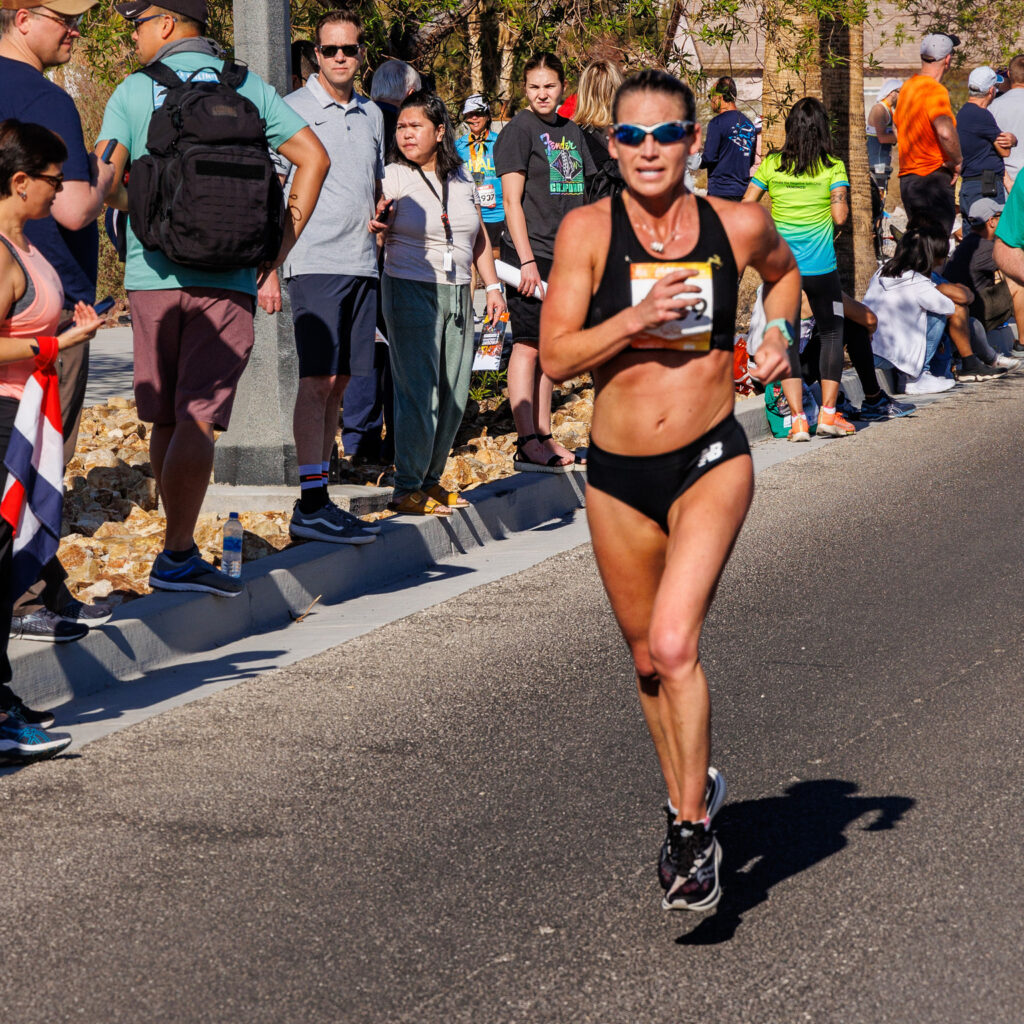
The Revel Race Series provides free photos from the course, so it was fun getting those within days of the race. As an organization, my experience was nothing but amazing with Revel. Selfishly, I wish the race was a few weeks earlier or an even earlier start time, because it was hot for those final miles. Coming from training in NY winters, 65 degrees and sunny felt like summer. But weather aside, it was pretty near perfect.
In the days following this marathon, my legs were pretty darn beat up. In fact, I don’t recall ever feeling so wrecked after a road marathon. This reminded me of how I’d felt after Ultra marathons in mountains, not a road race of 26.2 miles. I needed more rest and recovery following Mount Charleston than any other marathon I’ve raced. That said, totally worth it!
If you are looking for a beautiful course, a well organized event, and thrive on hills – this may be a great race for you! Note that if you are not trained for hills, or need a big-city vibe, this race is probably not your jam. I don’t regret my decision to change race courses for a second – and the gamble paid off. Deep down, I’d love to go back and race Mount Charleston again – ideally without the toe issue! Could I go under 2:55 on this course? I’m definitely interested to find out.
 The long run. The cornerstone of marathon training. The weekly run that is essentially “dress rehearsal” for marathon day. It’s the run most runners stress about, and the one that over times builds confidence and endurance fitness. A marathoner cannot be prepared for race day without consistent long runs under their belt, but there’s a lot of opinions, beliefs and falsehoods regarding the long run – especially the magical peak mileage number. It’s important to understand that coaches will have their own reasons for how long they take the long runs, and (hopefully) there’s science-based factors considered. Most non-coaches toss out “20 miles” as the long run distance every marathoner should hit. But I’m going to attempt to shed some light onto the reason for the long run, what mental and physical adaptions occur, the different types of long runs, and why the 20-miler staple is actually not always the correct number. So strap in, cause here we go!
The long run. The cornerstone of marathon training. The weekly run that is essentially “dress rehearsal” for marathon day. It’s the run most runners stress about, and the one that over times builds confidence and endurance fitness. A marathoner cannot be prepared for race day without consistent long runs under their belt, but there’s a lot of opinions, beliefs and falsehoods regarding the long run – especially the magical peak mileage number. It’s important to understand that coaches will have their own reasons for how long they take the long runs, and (hopefully) there’s science-based factors considered. Most non-coaches toss out “20 miles” as the long run distance every marathoner should hit. But I’m going to attempt to shed some light onto the reason for the long run, what mental and physical adaptions occur, the different types of long runs, and why the 20-miler staple is actually not always the correct number. So strap in, cause here we go!
 On May 15th I ran my first solo marathon since Boston 2015. My goal was simple: lock in a BQ. While I felt pretty confident I’d complete a 3:15-3:30 marathon, a whole lot can happen in the course of 26.2 miles. Plus, this marathon was a short two weeks since my “A” race for 2016, the Broad Street Run.
On May 15th I ran my first solo marathon since Boston 2015. My goal was simple: lock in a BQ. While I felt pretty confident I’d complete a 3:15-3:30 marathon, a whole lot can happen in the course of 26.2 miles. Plus, this marathon was a short two weeks since my “A” race for 2016, the Broad Street Run.